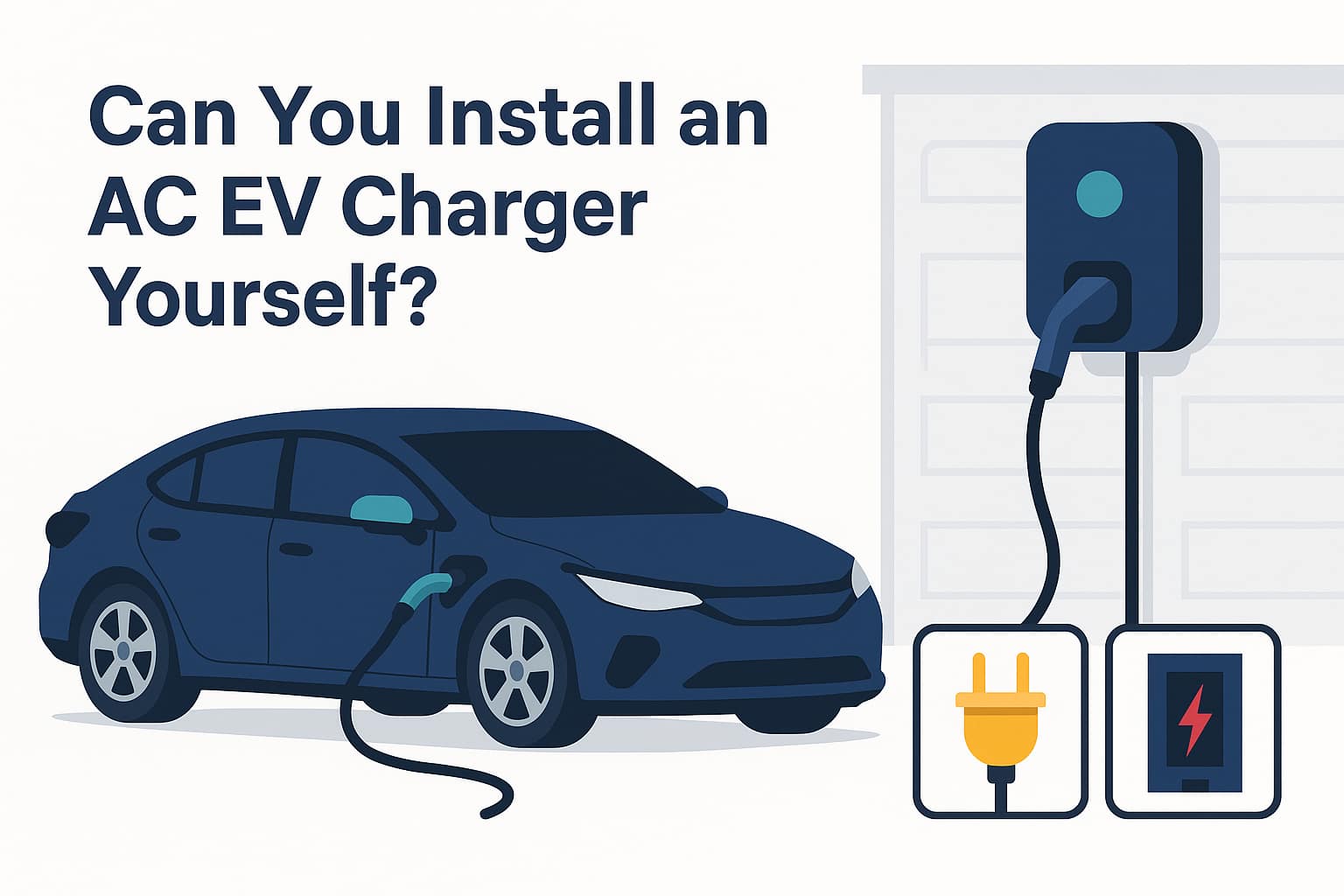

نعم، في بعض الأحيان. تعتبر شواحن التيار المتردد القابلة للتوصيل (على سبيل المثال، أنواع قابس NEMA 5‑15، أو 6‑20، أو 14‑50، أو IEC) عملية DIY واقعية إذا تم تصنيفها بشكل مناسب، موجود المقبس موجود بالفعل و متوافق مع الكود .
أنظمة EVSE السلكية، أو الدوائر الجديدة، أو ترقيات اللوحة تتطلب عموما التصاريح والتفتيش وغالباً كهربائي مرخص .تفرض العديد من الولايات القضائية ذلك.
المسار الآمن: أكمل قائمة التحقق من الأهلية ، قم بإجراء حساب الحمل ، تصاريح السحب ، واتبع قائمة التحقق من التشغيل إذا كان هناك أي شيء غير واضح، استعن بشخص محترف.
تنصل: الأعمال الكهربائية خطرة وتخضع للوائح. تختلف القوانين باختلاف البلد والمدينة (NEC/CEC/IEC/GB/T والتعديلات المحلية). يُرجى اعتبار هذا دليلاً إرشادياً، وليس بديلاً عن تعليمات الجهة المختصة (AHJ) أو تعليمات الشركة المصنعة.
EVSE: معدات تزويد المركبات الكهربائية - ما يُطلق عليه الكثيرون "شاحن/كومة شحن". تُوصل هذه المعدات التيار المتردد بأمان إلى الشاحن الموجود في سيارتك.
المستوى 1/المستوى 2 (أمريكا الشمالية): شحن منزلي بتيار متردد ~١٢٠ فولت / ~٢٤٠ فولت. في أماكن أخرى: تيار متردد أحادي الطور بجهد مختلف.
الحمل المستمر: من المتوقع أن يتم تشغيل الحمل لمدة ≥3 ساعات؛ ويعتبر EVSE مستمرًا عادةً.
قاطع الدائرة الأرضية/قاطع الدائرة الكهربائية: حماية من الأعطال الأرضية - أمريكا الشمالية: قاطع الدائرة الأرضية (GFCI). مناطق IEC: قاطع الدائرة الكهربائية المتولدة (RCD) (النوع A، F، B). العديد من أجهزة EVSE مزودة بحماية مدمجة؛ قد تحتاج دائرتك إلى حماية ضد التيار الصاعد.
يمكنك أن تفكر في القيام بالأمر بنفسك فقط إذا كانت كل الأمور صحيحة:
نِطَاق: أنت تقوم بتوصيل EVSE المدرجة في مقبس موجود ومصنف بشكل مناسب (داخلي أو خارجي) يتوافق بالفعل مع الكود، أو أنت تقوم بتركيب المكونات الإضافية EVSE دون تغيير الأسلاك الثابتة.
حالة: تظهر لك اللوحة والقواطع والمقبس لا توجد علامات على التلف الناتج عن الحرارة أو التآكل أو الوصلات الفضفاضة .
حماية: مطلوب قاطع الدائرة الأرضية/قاطع الدائرة المتجمدة و التيار الزائد يجب أن تكون الحماية موجودة للموقع (الجراج، موقف السيارات، الخارج).
سعة: أ حساب الحمل يُظهر أن الخدمة والمغذي الخاصين بك يمكنهما التعامل مع حمل EV المضاف.
تعليمات الشركة المصنعة واضحة، وأنت تملك ما يلزم أدوات (مفك عزم الدوران/مفتاح الربط، مقياس متعدد، جهاز تحديد المسامير، مثقاب، معدات الوقاية الشخصية).
التصاريح/جمعية أصحاب العقارات: AHJ و HOA/المالك الخاص بك يسمح النهج الذي اخترته بدون أسلاك ثابتة جديدة .
إذا فشل أي عنصر - أو كنت تخطط التوصيلات الكهربائية ، تثبيت مقبس/دائرة جديدة ، أو ترقية اللوحة - تعيين كهربائي مرخص.
يعد اختيار تيار EVSE بمثابة توازن بين القيادة اليومية ، وقت السكن ، و سعة اللوحة .
قياس الحجم السريع
المسافة المقطوعة يوميًا × (كيلوواط/ساعة لكل ميل) ≈ الطاقة اليومية. السيارات الكهربائية النموذجية: 0.25–0.35 كيلووات ساعة/ميل (4–3 ميل/كيلووات ساعة) .
طاقة الشحن المطلوبة ≈ الطاقة اليومية / ساعات الشحن المتاحة.
مثال : 40 ميلًا/يومًا × 0.3 كيلوواط/ساعة/ميل = 12 كيلوواط ساعة/يوم مع 8 ساعات ليلية، 12 ÷ 8 ≈ 1.5 كيلو واط حتى بطارية 120 فولت، 12 أمبير، المستوى 1 (حوالي 1.4 كيلو واط) يمكنها الحفاظ على هذا. للتخزين المؤقت أو الشحن السريع، ارفع مستوى البطارية إلى 32 أمبير (7.7 كيلو واط) أو 40–48 أمبير (9.6–11.5 كيلو واط) المستوى 2 EVSE إذا سمحت لوحتك بذلك.
اعتبارات الموصل
أمريكا الشمالية/اليابان: SAE J1772 (النوع 1) للسيارات غير التابعة لشركة Tesla؛ تتمتع شركة Tesla بنظام NACS؛ وتوجد محولات.
الاتحاد الأوروبي/معظم دول العالم: النوع 2 (IEC 62196‑2).
يضمن طول الكابل (5-8 م نموذجيًا) يصل إلى منفذ الشحن دون إجهاد.
سير عمل مبسط (قد يتطلب AHJ الخاص بك نموذجًا محددًا):
قائمة الأجهزة الثابتة (تكييف الهواء، الموقد، المجفف، سخان المياه، وما إلى ذلك).
يتقدم عوامل الطلب وفقًا للرمز المحلي لتقدير حمل الخدمة (راجع أوراق العمل الرسمية).
أضف EVSE كـ حمل مستمر في مكانها لوحة الاسم الحالية .
تأكد من تقييم الخدمة (على سبيل المثال، 100 أمبير، 200 أمبير) و وحدة التغذية يمكن أن يدعم المجموع. إذا لم يكن كذلك، ففكر في إدارة التحميل ، أ EVSE ذات التيار المنخفض ، أو أ ترقية الخدمة .
توفر العديد من 40 A EVSEs 32 أمبير مستمر وتتطلب قاطع 40 أمبير . أ 48 أ عادةً ما تحتاج EVSE السلكية إلى قاطع 60 أمبير وموصلات أكبر. احرص دائمًا على مطابقة حجم القاطع والموصل لتعليمات EVSE وجداول الكود المحلية، مع مراعاة تصنيف درجة الحرارة وتخفيض التصنيف.
للتوضيح فقط. التحقق من جداول الكود، وتصنيفات المعدات 60/75 درجة مئوية، ودرجة الحرارة المحيطة، وخفض التصنيف.
| مخرج EVSE (أمبير) | الحمل المستمر (أ) | مين بريكر (أ) | مقياس AWG النحاسي النموذجي (التشغيلات القصيرة) | ملحوظات |
|---|---|---|---|---|
| 16 | 16 | 20 | 12 مقياس سلكي | غالبًا في دوائر 120 فولت أو 240 فولت. |
| 24 | 24 | 30 | 10 AWG | مشترك لوحدات 5.7 كيلو وات. |
| 32 | 32 | 40 | 8 AWG | حجم المنزل الشائع (~7.7 كيلو واط عند 240 فولت). |
| 40 | 40 | 50 | 6–8 AWG | تحقق من تصنيف EVSE؛ 6 AWG أكثر أمانًا لمسافات أطول. |
| 48 | 48 | 60 | 6 AWG | يتم توصيله سلكيًا فقط في كثير من الحالات. |
ل الجري لمسافات طويلة ، تصميم ل انخفاض الجهد أقل من 3% ؛ وهذا يعني في كثير من الأحيان زيادة حجم الموصل.
الدائرة المخصصة: يجب أن يكون EVSE على دائرة فرعية مخصصة -لا تشارك مع الأحمال الأخرى.
حماية من الأعطال الأرضية:
EVSE المغذية بالمقبس (المرائب/الأماكن الخارجية): حماية GFCI هي مطلوب بشكل شائع تتضمن العديد من أنظمة المركبات الكهربائية (EVSE) حماية متكاملة من الأعطال الأرضية. نسّق لتجنب الرحلات المزعجة والتزم بالقواعد المحلية.
مناطق IEC: يستخدم كشف RCD من النوع A + 6 مللي أمبير تيار مستمر (غالبا ما تكون متكاملة) أو النوع B RCD في الاتجاه المعاكس، وفقًا لإرشادات الشركة المصنعة.
AFCI (حيثما ينطبق ذلك): بعض المساكن تتطلب AFCI في مناطق معينة؛ قد تُستثنى المرائب/الأماكن الخارجية. تأكد من ذلك محليًا.
التأريض/التأريض والترابط: صيانة موصلات تأريض المعدات (EGCs) وربط مسارات/أغلفة المعادن.
التثبيتات الخارجية: يستخدم المرفقات المقاومة للعوامل الجوية المدرجة ، أغطية قيد الاستخدام للمقابس، حلقات التنقيط ، مقاوم للأشعة فوق البنفسجية الأنابيب/الكابلات (على سبيل المثال، PVC Sch 80، EMT، أو ما يعادلها)، والمسافات المناسبة.
المكون الإضافي (على سبيل المثال، NEMA 14‑50/6‑50، وSchuko، وBS1363، وما إلى ذلك)
مرنة، وسهلة الاستبدال/النقل.
غالبًا ما تكون صديقة للمشاريع المنزلية إذا كانت المقبس الحالي متوافق وتم تقييمه بشكل صحيح.
وعاء قواعد GFCI والإغلاق قد ينطبق؛ تأكد من صحة ملء الصندوق و عزم الدوران .
سلكي
مظهر أنظف، تيار أعلى في كثير من الأحيان (على سبيل المثال، 48 أمبير)، وفرصة أقل للحرارة عند القابس.
عادة ما يتطلب يسمح و كهربائي مرخص ؛ اتبع مواصفات كبلات التوصيل وتخفيف الضغط وعزم الدوران المحددة من قبل الشركة المصنعة.
وحدة EVSE، قالب التثبيت، المراسي.
صحيح قاطع (على سبيل المثال، 40/50/60 A، GFCI/AFCI إذا لزم الأمر، مطابقة للعلامة التجارية للوحة).
موصلات النحاس الحجم حسب الخطط (THHN/THWN‑2 في القناة أو الكابل المقدر بشكل مناسب).
مشابك الأنابيب/التجهيزات أو الكابلات؛ الصناديق/الأغطية المقاومة للعوامل الجوية للاستخدام في الأماكن الخارجية.
مفك عزم الدوران/مفتاح ربط ، جهاز قياس متعدد، جهاز اختبار الجهد بدون تلامس، جهاز تحديد المسامير، مستوى، مثقاب، معدات الحماية الشخصية (قفازات، نظارات أمان).
اتبع دليل EVSE بدقة. فيما يلي نوعي مخطط لمساعدتك على فهم التدفق.
اختر موقعًا مع الموافقات وفقًا للدليل؛ تجنب الأضرار الميكانيكية، ونفاثات المياه، وإطارات السيارة.
إذا كنت في الخارج، قم بالتركيب تحت غطاء عندما يكون ذلك ممكنًا؛ ضع في اعتبارك التعرض للشمس و حلقات التنقيط .
استخدم القالب؛ ادفع المراسي في العوارض/البناء؛ تحقق تصنيف الحمل .
يمد تخفيف التوتر للكابل؛ أضف خطاف/حافظة لحماية الموصل.
التفتيش البصري: لا يوجد تغير في اللون، أو شقوق، أو حاوية فضفاضة؛ العلبة آمنة ومختومة.
التحقق من التقييم: يجب أن يتطابق المقبس والقاطع والأسلاك الدائرة مع تصنيف قابس EVSE (على سبيل المثال، 14-50 على دائرة 50 أمبير بمقياس صحيح).
اختبار GFCI/RCD: تأكد من أن رحلات الجهاز العلوي وإعادة تعيينه بشكل صحيح.
قياس الجهد/القطبية/الأرض: باستخدام مقياس متعدد، تأكد من الجهد الاسمي والأسلاك الصحيحة.
جبل EVSE قم بتوجيه الكابل لتجنب مخاطر التعثر، ثم قم بتوصيله.
تصريح وخطة: قم بإرسال حساب الأحمال، ومخطط الخط الواحد، وخطة الموقع إذا لزم الأمر.
إلغاء تنشيط وإغلاق: افتح القاطع الرئيسي أو قاطع التغذية؛ وتأكد من عدم وجود أي جهد.
تركيب القناة/الكابل من اللوحة إلى تقاطع EVSE حسب طريقة التوصيل؛ اترك حلقة التنقيط.
إنهاء الموصلات لمواصفات عزم الدوران؛ قم بتثبيت قاطع مخصص حجمها حسب اسم اللوحة.
ملصق افصل قاطع الدائرة ومفتاح الطاقة الكهربائية (EVSE) إذا كانا منفصلين. حافظ على مسافات عمل كافية.
التفتيش والتنشيط: اجتياز التفتيش، ثم التنشيط والتشغيل.
تم تأمين حاوية EVSE؛ وتم تثبيت تخفيف إجهاد الكابل؛ وتم وضع الموصل في حافظة.
حجم القاطع و مقياس الموصل خطة المباراة؛ الإنهاءات مصممة حسب المواصفات.
عطل أرضي/قاطع تيار متبقي تم التحقق من الحماية (زر الاختبار يعمل؛ وقت الرحلة معقول).
إعدادات الاتصال تم تكوين (Wi-Fi/OCPP)؛ وتم تحديث البرامج الثابتة إذا لزم الأمر.
مصافحة السيارة :ابدأ جلسة؛ تأكد من التيار المتوقع (على سبيل المثال، 32 أمبير) على EVSE/التطبيق.
الفحص الحراري بعد 15-30 دقيقة من التحميل الكامل: استخدم مقياس حرارة الأشعة تحت الحمراء على القابس، وواجهة المقبس، ونقاط القاطع، والغطاء. لا توجد بقع ساخنة (> ٦٠-٧٠ درجة مئوية) أو رائحة.
إدارة الكابلات :لا توجد نقاط ضغط؛ نصف قطر انحناء مناسب.
التوثيق :سجل الرقم التسلسلي، ومعرف القاطع، والصور، وسجلات التفتيش/التصاريح.
موصلات صغيرة الحجم أو مسافات طويلة دون مراعاة انخفاض الجهد → تكبير حجم السلك .
خلط الألومنيوم والنحاس بدون عروات/مضادات أكسدة مناسبة → استخدم موصلات مصنفة أو التزم بالنحاس.
تجاهل مواصفات عزم الدوران → استخدم محرك عزم الدوران المعاير؛ قم بإعادة عزم الدوران بعد دورات الحرارة الأولية إذا سمح المصنع بذلك.
نوع الحماية خاطئ (لا يوجد GFCI حيثما كان ذلك مطلوبًا، أو نوع RCD خاطئ) → تأكد من ذلك باستخدام دليل AHJ وEVSE.
الصناديق المزدحمة وتخفيف الضغط الضعيف → قم بملء مربع الاختيار واملأ الحسابات وقم بتثبيت غدد الكابلات.
أنت بحاجة إلى دائرة جديدة ، نظام EVSE السلكي ، أو ترقية الخدمة/اللوحة .
لك حساب الحمل قريب من حد الخدمة.
أنت غير متأكد من GFCI/RCD/AFCI متطلبات.
التثبيت هو في الهواء الطلق ، على البناء/المعدن ، أو في خطير أو رطوبة المواقع.
عقارات متعددة العائلات أو تجارية حيث إمكانية الوصول ، التواصل ، إدارة التحميل ، و الفواتير موضوع.
التركيب القابل للتوصيل فقط: 0–150 دولارًا أمريكيًا للمواد (أدوات التثبيت والخطافات). 1–2 ساعة.
مقبس جديد على السعة الحالية: ٢٠٠-٨٠٠ دولار أمريكي للمواد + العمالة (حسب البلد). نصف يوم.
الأنابيب السلكية أو طويلة المدى: 500 دولار إلى 2000 دولار أمريكي+ اعتمادًا على الطول والجدران والتصاريح. 1-2 يوم.
ترقية اللوحة/الخدمة أو العداد/المجموعة الرئيسية: 2000 دولار إلى 8000 دولار+ وجدولة المرافق.
تختلف التكاليف بشكل كبير حسب المنطقة. اطلب عروض أسعار مفصلة وتأكد من تضمين التصاريح والفحص.
DIY ممكن للتركيب والتوصيل في موجود، متوافق الدائرة.
أي شيء يتعلق بالأسلاك الجديدة عادة ما يطالب التصاريح والتفتيش والكهربائي المرخص .
أ خطة مدروسة، وحماية مناسبة، وتكليف شامل هي مفاتيح التثبيت الموثوق به لـ AC EVSE.
اشترك معنا للتمتع بأسعار الفعاليات والحصول على أفضل الأسعار .
 دعم شبكة IPv6
دعم شبكة IPv6

